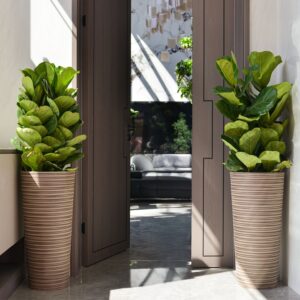Choosing Large Decorative Planters: Balancing Beauty and Brawn for the Outdoors
When selecting large decorative planters for your outdoor spaces, you need to consider both their visual appeal and their ability to withstand the weight of mature plants and the rigors of the outdoor environment. For American gardeners and homeowners looking for the perfect combination of style and durability, here’s a guide to some of the best materials for large outdoor planters:
Key Considerations for Large Outdoor Planters
- Durability: The material should be able to withstand various weather conditions like rain, sun, wind, and temperature fluctuations, including potential frost.
- Weight Capacity: Large plants, especially trees or shrubs in containers, can be quite heavy. The planter needs to be sturdy enough to support this weight without cracking or collapsing.
- Aesthetics: The planter should complement your outdoor décor and personal style, adding to the overall beauty of your garden, patio, or deck.
- Size and Shape: Ensure the planter is appropriately sized for the mature size of the plant you intend to grow in it and fits well in your chosen outdoor location.
Top Materials for Large, Decorative, and Durable Outdoor Planters
1. Fiberglass:
- Aesthetics: Fiberglass planters are incredibly versatile in terms of style and finish. They can be molded to mimic the look of various other materials like stone, terracotta, or metal, and come in a wide array of colors and modern shapes.
- Durability: Fiberglass is a top choice for durability. It is lightweight yet very strong, weather-resistant (including UV and frost), and won't crack or fade easily. This makes it an excellent option for large plants in challenging outdoor conditions.
2. Metal (Galvanized Steel, Aluminum, Copper):
- Aesthetics: Metal planters offer a sleek, modern, or industrial look.Galvanized steel provides a robust and contemporary feel, aluminum is lightweight and can be powder-coated in various colors, and copper develops a beautiful patina over time for a more traditional or rustic appearance.
- Durability: Metal planters are generally very durable and can withstand harsh weather. Galvanized steel and aluminum are rust-resistant, while copper is highly corrosion-resistant. They are strong enough to support the weight of large plants.
3. Concrete:
- Aesthetics: Concrete planters have a solid, substantial presence that can suit modern, minimalist, or even some rustic garden designs. They can be left in their natural gray tone or stained or painted for added color.
- Durability: Concrete is exceptionally durable and can withstand all types of weather. Its weight also makes it very stable, which is ideal for large plants that might be top-heavy or in windy locations.
4. Stone (Natural Stone, Cast Stone):
- Aesthetics: Stone planters exude a timeless elegance and can seamlessly blend into formal or traditional garden settings. Natural stone planters have unique variations, while cast stone offers more design flexibility.
- Durability: Stone is one of the most durable materials for outdoor use, able to withstand extreme weather conditions and heavy weight.10 However, natural stone can be quite heavy and expensive.
5. Wood (Cedar, Teak, Redwood):
- Aesthetics: Wooden planters offer a natural, warm, and inviting look that works well in many garden styles, from cottage to contemporary. Cedar, teak, and redwood are popular choices due to their natural resistance to rot and decay.
- Durability: While wood is durable, it will eventually weather and may require some maintenance like staining or sealing to prolong its lifespan, especially in very wet climates. However, these types of wood are generally sturdy enough for large plants.
Materials to Consider with Caution for Large Outdoor Plants:
- Terracotta: While aesthetically pleasing and good for drainage, large terracotta planters can be heavy and are susceptible to cracking in freezing temperatures. They might require extra protection or relocation in colder climates.
- Plastic/Resin (Lower Quality): While affordable and lightweight, lower-quality plastic or resin planters may not be sturdy enough to support the weight of very large plants or withstand harsh outdoor conditions long-term, potentially cracking or warping.
Conclusion:
For large decorative planters that need to be both beautiful and durable enough for outdoor use, fiberglass, metal, concrete, and stone are excellent choices, offering a combination of style, strength, and weather resistance. Wood can also be a good option with proper care. Consider the specific aesthetic you desire, the climate you live in, and the weight of your mature plants when making your selection.
Article copyright by GreenShip


Comments
Post a Comment